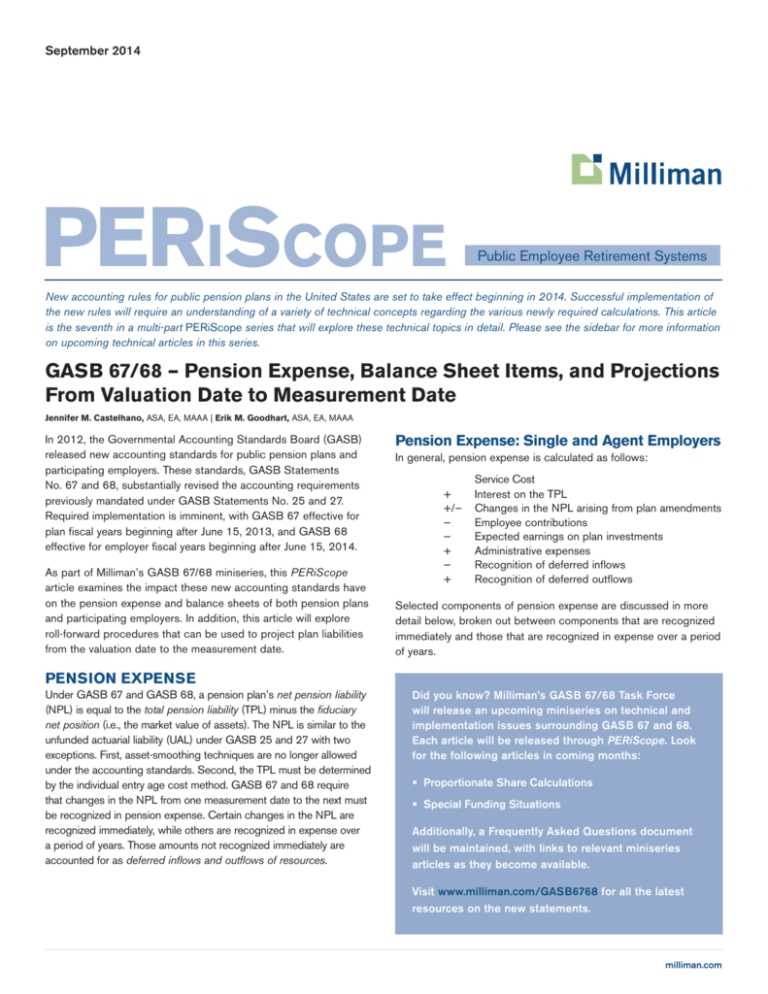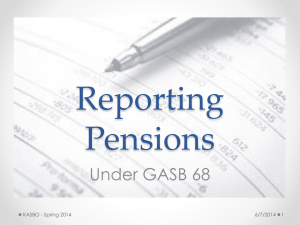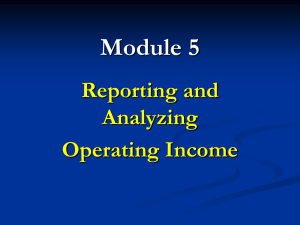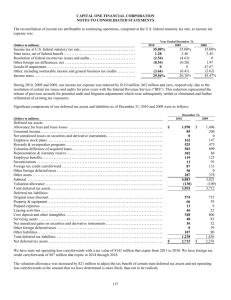
September 2014
PERISCOPE
Public Employee Retirement Systems
New accounting rules for public pension plans in the United States are set to take effect beginning in 2014. Successful implementation of
the new rules will require an understanding of a variety of technical concepts regarding the various newly required calculations. This article
is the seventh in a multi-part PERiScope series that will explore these technical topics in detail. Please see the sidebar for more information
on upcoming technical articles in this series.
GASB 67/68 – Pension Expense, Balance Sheet Items, and Projections
From Valuation Date to Measurement Date
Jennifer M. Castelhano, ASA, EA, MAAA | Erik M. Goodhart, ASA, EA, MAAA
In 2012, the Governmental Accounting Standards Board (GASB)
released new accounting standards for public pension plans and
participating employers. These standards, GASB Statements
No. 67 and 68, substantially revised the accounting requirements
previously mandated under GASB Statements No. 25 and 27.
Required implementation is imminent, with GASB 67 effective for
plan fiscal years beginning after June 15, 2013, and GASB 68
effective for employer fiscal years beginning after June 15, 2014.
As part of Milliman’s GASB 67/68 miniseries, this PERiScope
article examines the impact these new accounting standards have
on the pension expense and balance sheets of both pension plans
and participating employers. In addition, this article will explore
roll-forward procedures that can be used to project plan liabilities
from the valuation date to the measurement date.
Pension Expense: Single and Agent Employers
In general, pension expense is calculated as follows:
+
+/—
—
—
+
—
+
Service Cost
Interest on the TPL
Changes in the NPL arising from plan amendments
Employee contributions
Expected earnings on plan investments
Administrative expenses
Recognition of deferred inflows
Recognition of deferred outflows
Selected components of pension expense are discussed in more
detail below, broken out between components that are recognized
immediately and those that are recognized in expense over a period
of years.
PENSION EXPENSE
Under GASB 67 and GASB 68, a pension plan’s net pension liability
(NPL) is equal to the total pension liability (TPL) minus the fiduciary
net position (i.e., the market value of assets). The NPL is similar to the
unfunded actuarial liability (UAL) under GASB 25 and 27 with two
exceptions. First, asset-smoothing techniques are no longer allowed
under the accounting standards. Second, the TPL must be determined
by the individual entry age cost method. GASB 67 and 68 require
that changes in the NPL from one measurement date to the next must
be recognized in pension expense. Certain changes in the NPL are
recognized immediately, while others are recognized in expense over
a period of years. Those amounts not recognized immediately are
accounted for as deferred inflows and outflows of resources.
Did you know? Milliman’s GASB 67/68 Task Force
will release an upcoming miniseries on technical and
implementation issues surrounding GASB 67 and 68.
Each article will be released through PERiScope. Look
for the following articles in coming months:
Proportionate Share Calculations
Special Funding Situations
Additionally, a Frequently Asked Questions document
will be maintained, with links to relevant miniseries
articles as they become available.
Visit www.milliman.com/GASB6768 for all the latest
resources on the new statements.
milliman.com
PERISCOPE
Public Employee Retirement Systems
Pension Expense: Cost-sharing Employers
Pension Expense Items Requiring Immediate Recognition
The plan’s service cost (i.e., gross normal cost), measured at
the beginning of the measurement period, is included in pension
expense. The service cost must be determined using the individual
entry age (level percentage of pay) actuarial cost method. Benefits
should be attributed over a period that begins when the employee
starts accruing benefits under the terms of the plan and ends when
the employee separates service. In situations where a plan offers a
Deferred Retirement Option Program (DROP) to participants, the date
of entry into the DROP should be considered as the separation date.
While the general approach for calculating pension expense for
a cost-sharing employer plan is similar to that used for single and
agent employer plans, there are a few notable differences. First,
changes in the collective deferred inflow and outflow of resources
due to changes in the employer’s proportion of the collective NPL
since the last measurement date must be recognized in expense.
Second, any difference between actual employer contributions and
the employer’s proportionate share of the total of all contributions
from all employers must be recognized in expense. In both cases,
these changes must be amortized over a closed period equal to the
expected remaining service lives of all pension plan participants,
not the expected remaining service lives for participants of a select
group of individual employers.
One year’s interest on the TPL is also included in pension
expense. Interest on the service cost, offset by interest on benefit
payments (including refunds of employee contributions) during the
measurement period, should also be included. Interest should be
calculated using the plan’s discount rate assumption.
Deferred Inflows and Outflows of Resources:―
Single and Agent Employers
There are other sources of change in NPL that must be recognized
immediately in pension expense. They include, but are not limited to,
employee contributions, administrative expenses, and any change in
NPL arising from plan amendments.
Under the new GASB standards, changes in the NPL arising from
experience gains/losses, assumption changes, and differences
between projected and actual earnings on investments must be
recognized in expense over a period of years. Those amounts that
are not recognized in expense during the current reporting period
are accounted for as deferred inflows and outflows of resources.
Pension Expense Items Requiring Deferred Recognition
Certain changes in a plan’s NPL must be recognized in expense
over a period of years. Changes in NPL that arise due to
experience gains or losses fall into this category. These changes
should be amortized using a “systematic and rational method”
(e.g., straight line or level percentage of pay) over a closed period
equal to the expected remaining service lives of all pension plan
participants, both active and inactive.1 The expected remaining
service lives should be determined as of the beginning of the
measurement period.
Deferred inflows and outflows of resources that arise from
experience gains/losses or assumptions changes in different years
should not be expensed on a combined net basis. Rather, individual
bases, or “layers,” should be established with each new reporting
period and tracked until each has been fully recognized in expense.
However, in the notes to the financial statements, balances should
be aggregated for the purpose of reporting balances of deferred
inflows and outflows.
Changes in NPL that arise due to assumption changes must also
be recognized in expense over a period of years using the same
methodology as is used for experience gains/losses. However, a
change in NPL associated with an assumption change that is a
direct result of a plan change (for example, a change to the plan’s
retirement assumption due to a change in the normal retirement age)
must be recognized immediately.
Balances of deferred inflows and outflows of resources arising from
differences between projected and actual earnings on investments
in different periods, on the other hand, should be reported on a
net basis. If the net balance is a credit, it should be reported as a
deferred inflow of resources. If the net balance is a debit, it should
be reported as a deferred outflow of resources.
Finally, in addition to changes in NPL that have not been recognized
in pension expense, the deferred outflow of resources should also
include any employer contributions made after the measurement date
and before the end of the employer’s reporting period.
Changes in NPL that arise due to differences between projected and
actual earnings on pension plan investments must be recognized in
expense over a five-year period, beginning with the current reporting
period. Projected earnings should be calculated using the plan’s
long-term rate of return assumption, net of investment expenses.
Deferred Inflows and Outflows of Resources:―
Cost-sharing Employers
Q&A 83 of the GASB 68 implementation guide states that it is not
permissible for employers to apply a method that would recognize
the entire amount of changes in NPL attributable to experience
gains/losses, assumption changes, or differences in projected and
actual investment earnings in pension expense. That is, delayed
recognition must be used in these situations.
While the general approach for calculating the deferred inflows and
outflows of resources for a cost-sharing employer plan is similar
to that for single and agent employer plans, there are also a few
differences. As with single and agent employers, changes in NPL
attributable to experience gains/losses, assumption changes, and
differences between projected and actual earnings on investments
not recognized in expense during the current reporting period are
accounted for as deferred inflows and outflows of resources.
1 Please see the July 2014 PERiScope article “Calculation specifics on individual entry
age normal and recognition of deferred inflows/outflows” for more information on this
amortization process.
SEPTEMBER 2014
2
PERISCOPE
Public Employee Retirement Systems
However, cost-sharing employers have two additional sources
of deferred inflows and outflows of resources that are not
applicable to single or agent employer plans. First, if there are
changes in the employer’s proportion of the collective NPL since
the last measurement date, then any effect on the employer’s
proportionate share of the collective NPL, collective deferred
outflow of resources, or collective deferred inflow of resources
not recognized in expense is reported as a deferred item. Second,
any difference between actual employer contributions and the
employer’s proportionate share of the total of all contributions from
all employers not recognized in expense must be reported as a
deferred item.
Deferred amounts arising from these two sources in a given year
may be reported on a net basis. However, deferred amounts
resulting from these two sources may not be reported net of similar
deferred amounts arising in other periods.
PROJECTIONS FROM VALUATION DATE
TO MEASUREMENT DATE
An actuarial valuation is performed by taking a snapshot of the
pension plan’s membership and benefit provisions as of a valuation
date. Decisions about actuarial assumptions are also determined as
of the valuation date. Using this information, the actuary calculates
the TPL and other related figures as of this date.
GASB 67 and 68 require that the TPL must be determined as of the
measurement date. However, in some circumstances it may not be
practical to perform a valuation as of the measurement date. In such
situations the actuary can make use of update procedures to project or
“roll forward” the TPL from the valuation date to the measurement date.
If update procedures are used, the valuation date may be no more
than 24 months earlier than the fiscal year-end under GASB 67 and
no more than 30 months and 1 day earlier than the fiscal year-end
under GASB 68.2 In addition, any significant changes that have
occurred between the valuation date and the measurement date
must be reflected in the TPL. A significant change in the TPL can
result from either a single or combination of reasons. Examples of
events that may have a significant effect on TPL are:
GASB 67 and 68 do not establish specific procedures for applying
update procedures, but direct the actuary to apply professional
judgment in determining the necessary methods to estimate the
TPL as of the measurement date. The accounting standards also
state that among the factors to be considered is whether a new
actuarial valuation is needed. If an event that triggers a significant
change in the TPL is not reflected in the original valuation, the
actuary may be required to rerun the valuation. For example,
assume that a July 1, 2013 actuarial valuation is used for a June
30, 2014 measurement date and June 30, 2015 reporting date
(fiscal year-end). If a plan adopts a material change in benefit terms
on June 29, 2014, this change would need to be reflected in the
TPL, and would require a new actuarial valuation. The impact of
this change would need to be reflected even if the change is not
effective until a later date, say, June 30, 2017. However, changes
that occur subsequent to the measurement date are not reflected
in the TPL. In the same example, if the change was adopted on
July 1, 2014, it would not be reflected in the TPL until the next
measurement date (i.e., during the employer’s next fiscal year).
For plans that have actuarial valuations performed biennially, the
TPL should be reported based on a new measurement date each
year. This can generally be achieved through the use of update
procedures as described above, or it may be accomplished by
performing a new actuarial valuation. Whichever approach is taken
should be agreed upon by the actuary, auditor, and trustees.
Finally, while the TPL as of the measurement date can be based on
the results of an earlier actuarial valuation, the fiduciary net position
must be the market value of assets as of the measurement date.
Careful consideration should be given to the choice of both the
valuation date and measurement date. Once these dates have
been established, discuss with your actuary whether a roll-forward
calculation is necessary. This calculation is an important estimate,
and changes between the valuation date and measurement date
could have a material impact.
Jennifer M. Castelhano, ASA, EA, MAAA, is an associate actuary with the
Change in benefit terms
Hartford, CT office of Milliman. Contact her at jenn.castelhano@milliman.com.
Change in size or composition of covered group
Erik M. Goodhart, ASA, EA, MAAA, is an actuary with the Washington, D.C.
office of Milliman. Contact him at erik.goodhart@milliman.com.
Change in municipal bond rate or index rate component of the
discount rate
Change in the pension plan’s fiduciary net position that impacts
the discount rate used to calculate the plan’s TPL
2 For additional details, please see the March 2014 PERiScope article discussing the
relationship between valuation date, measurement date, and reporting date.
This publication is intended to provide information and analysis of a general nature. Application to specific circumstances should rely on separate professional
guidance. Inquiries may be directed to: periscope@milliman.com.
SEPTEMBER 2014
Copyright © 2014 Milliman, Inc. All Rights Reserved.







